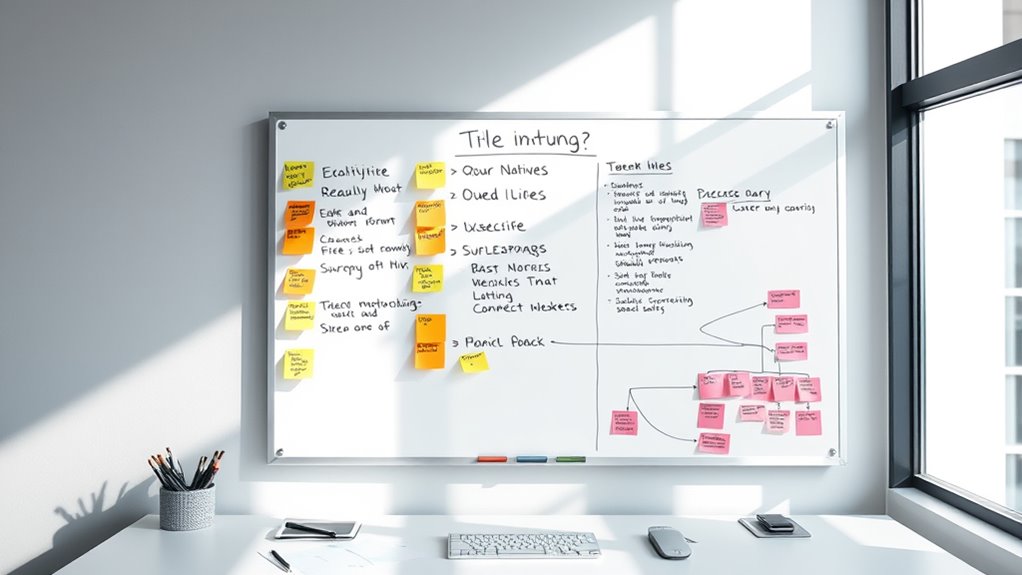Effective information hierarchy helps you organize content clearly by guiding viewers’ attention through a logical flow. You can do this by highlighting key points using size, color, and placement, making sure the most important details stand out. Using layout elements like whitespace, contrast, and visual pathways directs focus naturally and prevents clutter. By continuously refining your design, you’ll create a compelling structure that enhances understanding—continue exploring to master these essential techniques for clarity.
Key Takeaways
- Prioritize critical information using size, color, and placement to guide viewers’ focus effectively.
- Use headings, bold text, and larger fonts to highlight main ideas and establish clear hierarchy.
- Design layouts with visual pathways, whitespace, and alignment to naturally direct attention.
- Employ contrast and strategic spacing to differentiate key points from supporting details.
- Continuously refine your layout by testing arrangements and removing clutter for optimal clarity.

Understanding information hierarchy is essential for organizing data effectively, so you can prioritize what matters most and make better decisions. When you structure content with a clear hierarchy, you guide your audience’s attention through a logical flow, ensuring they grasp the most important points first. Visual flow plays a pivotal role here; it helps you design your layout so that viewers naturally follow the intended path of information. By establishing a strong visual flow, you create a seamless reading experience that directs eyes to key elements without confusion or distraction. This approach makes your content more engaging and easier to understand, especially when dealing with complex or dense information. Incorporating principles like contrast and spacing can further enhance the clarity of your hierarchy, making critical information stand out more effectively.
Effective content organization guides viewers seamlessly through key points and enhances understanding.
Content prioritization is at the heart of effective information hierarchy. You need to decide what information is most critical and present it prominently, whether through size, color, placement, or contrast. When you prioritize content properly, you prevent your audience from feeling overwhelmed or lost in a sea of data. Instead, they can quickly identify the main ideas and then explore supporting details at their own pace. A well-structured hierarchy emphasizes the hierarchy of importance, making it clear which points are essential and which are supplementary. This clarity enhances comprehension and retention, ensuring your message resonates effectively.
To achieve this, you should start by identifying your core message. Ask yourself what the primary takeaway should be and place that information at the top or center of your layout. Use visual cues like headings, bold text, or larger fonts to highlight key points. Visual flow can be reinforced with strategic use of whitespace, alignment, and visual pathways such as arrows or lines that lead the eye naturally from one section to the next. When you arrange content with these principles in mind, your audience intuitively knows where to focus first and how the information logically unfolds. Additionally, understanding the contrast ratio helps you optimize visual hierarchy by ensuring important elements stand out effectively.
Furthermore, balancing visual flow with content prioritization involves continuously refining your layout. Test different arrangements to see which version offers the clearest path for viewers. Remember, simplicity often enhances clarity—avoid clutter that distracts from your main points. When you successfully combine visual flow with prioritized content, you craft a compelling narrative that guides your audience effortlessly through your message. This structured approach not only improves understanding but also encourages engagement, making your content more impactful and memorable. Ultimately, mastering these principles empowers you to communicate more effectively, ensuring your information leaves a lasting impression.
Frequently Asked Questions
How Does Information Hierarchy Influence User Engagement?
You can boost user engagement by designing an effective information hierarchy that guides visual flow naturally. When content is well-structured, it reduces cognitive load, making it easier for users to find what they need and stay engaged. Clear headings, prioritized information, and logical layout help users navigate seamlessly, encouraging them to interact more. This thoughtful organization keeps attention focused and enhances their overall experience.
What Tools Are Best for Creating Content Hierarchies?
Creating content hierarchies is like building a foundation for a house; you need the right tools. Digital mind mapping software, like MindMeister or XMind, makes visualizing relationships easy. Content outlining tools, such as Scrivener or Workflowy, help organize ideas efficiently. These tools let you structure your content clearly, ensuring your audience can follow along effortlessly and stay engaged. Use them to craft a logical, impactful content hierarchy.
How Can Visual Design Improve Content Hierarchy?
Visual design improves content hierarchy by using color contrast and visual cues to guide your audience’s attention. Bright, contrasting colors highlight key information, making it stand out, while subtle cues like spacing, size, and icons direct the eye smoothly through your content. You create a clear flow that helps users quickly find what they need, enhancing understanding and engagement without overwhelming them. Good visual hierarchy makes your content more accessible and effective.
What Are Common Mistakes in Structuring Content?
You might think your content is clear, but common mistakes like creating content clutter or using inconsistent labeling can confuse your audience. Avoid overcrowding pages with too much information or using inconsistent headings and categories. These errors make it hard for users to find what they need quickly. Instead, focus on organizing content logically, using clear labels, and decluttering pages to enhance understanding and improve overall readability.
How Does Audience Type Affect Hierarchy Design?
You should consider audience segmentation because it influences how you prioritize content. Different audience types have unique needs and knowledge levels, so you tailor your hierarchy accordingly. For example, expert users may want advanced details upfront, while beginners need foundational info first. By understanding your audience, you can optimize content prioritization, making your structure more effective and engaging for each segment. This guarantees clarity and better user experience.
Conclusion
By mastering information hierarchy, you make content clearer and more engaging. When you structure your information thoughtfully, your audience can easily find what matters most. Did you know that readers only spend about 15 seconds on a page before deciding to stay or leave? That’s why organizing your content effectively isn’t just helpful — it’s essential. Take control of your content today, and guarantee your message resonates quickly and powerfully with everyone who reads it.









